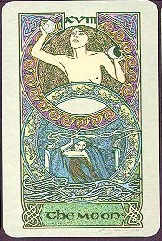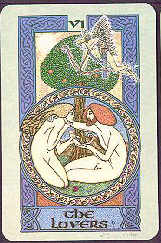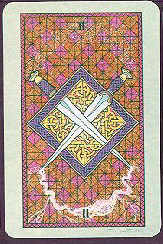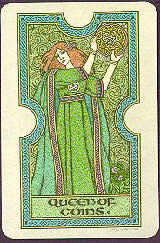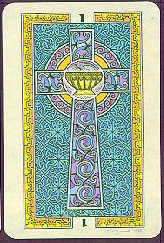Celtic Tarot Deck Review
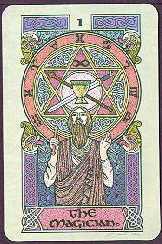
The Celtic Tarot features traditional Celtic knotwork and mythology, gorgeous colours, and very intricate detail on every card. The minor arcana are essentially pip cards in the same interwoven knotwork style.
Deck Type: Tarot Deck Cards: 78
Creators: Courtney Davis, Helena Paterson
Publisher: Thorsons 1990
Retailers
See Price at Amazon.comSee Price at Amazon.co.uk
See Price at Amazon.ca
Celtic Tarot Review by Steve Winick
This is the first Tarot deck that I bought, soon after it was published in 1990. As a longtime student of Celtic art, archaeology, and especially folklore, I was as taken with the Celtic mythological aspects as I was with Tarot. Indeed, I did not pick up Tarot studies for another ten years. This review is thus from the perspective of a folklore scholar with a longstanding interest in Celtic studies who is also, more recently, a Tarot seeker and enthusiast.
This is a sturdy, solid deck of cards that will serve Tarot readers for many years. It is a standard 78-card deck with 22 Major Arcana and 56 Minor Arcana, divided into suits called cups, coins, swords, and wands. It’s a beautiful deck that I think will be of interest to collectors and lovers of Celtic art. It presents some challenges to readers, however, and will therefore be most useful to advanced practitioners. The book that comes with the deck, furthermore, contains a fair bit of nonsense about the Celts and about Tarot, along with its relatively good descriptions of individual cards and their meanings.
Let’s begin with the art. Courtney Davis paints beautiful pictures in a style influenced primarily by early medieval Hiberno-Saxon Christian manuscript illumination. If that sounds like a mouthful, think of bearded saints, whimsical animal heads, and coiled and interlaced abstract patterns of the type found in the Book of Kells, the Codex Aureus, and the Lindisfarne gospels. Some of Davis’s images, such as The World, could come directly from such manuscripts, but for most he employs this general look, and adds bright colors (primarily jewel tones), an unusual speckled finish, and touches of other artistic styles. These can range from modern comic-book drawing, which seems to have influenced the face of The Empress, to classical painting, from which the figure of Cupid on the Lovers card derives. In particular, he incorporates other Celtic art styles, and those who have studied Celtic art and archaeology in any depth will be delighted with some of his references. The Desborough and Holcombe mirrors, Celtic artifacts from Davis’s own neighborhood in England, are the points of reference for the circular field behind The Emperor, while statues of goddesses like Covetina (who appears by a stream, holding two vessels, and draped in an open robe that reveals her naked form) have clearly influenced The Star. Even the vessels held by the goddess in The Star reference other Celtic art; they are a matching pair of La Tene-style bronze flagons, much like a well-known pair from a grave in the Moselle region of France.
Davis’s Major Arcana cards bear figures of Celtic mythology and some of the major Arthurian figures, while his court cards show other characters from Arthurian romance. Thus, the Lovers are Tristan and Iseult, the Emperor is Arthur, and the Hermit Merlin; Justice is the Irish Goddess Danu, The Moon the Welsh goddess Arianrhod, and The Chariot the Irish warrior Cuchulain; The Knight of Wands is Percival, the Queen of Swords Morgane le Fay, and the King of Coins Lot of Orkney. Of course, since the time Davis created this deck, a wealth of Arthurian decks have flourished, including the Arthurian, Legend, Avalon and Merlin decks; this makes me wish he had stuck to more obscure corners of Celtic mythology, where there are many scenes and characters he could have drawn upon. Nevertheless, the art on the Major Arcana and court cards remains a primary reason to seek out this deck.
The difficulties presented to readers stem primarily from the fact that the numbered cards of the Minor Arcana are pip cards, containing geometric arrangements of wands, swords, cups and coins. Some of these cards, including the entire suit of coins, are identical whether reversed or upright, so using reversed cards is impossible. Furthermore, the book by Helena Paterson instructs us to read the cards using the system of dignified and ill-dignified cards, without ever describing how to judge well-dignified from ill. The result is a deck that is rather confusing to use for readings, and one that requires further research to use effectively. In particular, those accustomed to Rider-Waite decks and their derivatives will need to keep on their toes, while those accustomed to Crowley decks or Marseilles style decks might feel more at home.
In its favor, I find it an excellent deck for meditation on card meanings. Looking at cards from a Celtic perspective can shed new light on their meanings. Sometimes this requires taking Paterson’s book with a grain of salt. For example, Paterson writes:
The Chariot is a card of action, but the charioteer has perfect control of all the elements and energies of the universe. The mightiest hero and charioteer of the Celtic race, Cuchulain, was born with a druid’s prophecy. The prophecy contained the message of the card, and went thus: ‘His praise will be in the mouths of all men; charioteers and warriors, kings and sages will recount his deeds; he will win the love of many. This Child will avenge all your wrongs; he will give combat at your fords, he will decide your quarrels.’
Cuchulain, Paterson says, is a “hero and charioteer.” But the prophecy, which she quotes from T.W. Rolleston’s version of the legend, tells us that “warrior” and “charioteer” are two different job descriptions. As readers of the Ulster cycle of myths will know, in the style of warfare described in the Ulster cycle, warriors battle each other from chariots that are driven by charioteers. The charioteer serves the warrior as a combination of driver and squire, offering advice on tactics, the selection of weapons, and the approach to an enemy. A good charioteer is an essential helper to a good warrior. Cuchulain’s charioteer, Láeg, is an important supporting character in the Ulster cycle, and one of the secrets of Cuchulain’s success. When Cuchulain is discouraged, Láeg acts as a sort of coach, giving him a pep talk; when Cuchulain needs a more serious boost, Láeg insults him, sending him into a berserker rage; when Cuchulain is wounded, Láeg summons healers to help him. Cuchulain was not alone in his reliance on a good charioteer; Julius Caesar, on encountering war chariots in Britain, remarked on the uncanny skill and poise of the charioteers more than on the skill of the fighters.
The knowledge that the Celtic chariot is driven by a separate person, who acts as guide, squire, and friend, is potentially useful in interpreting The Chariot, which is so often seen as a card of individual achievement and solitary struggle; in Thirteen’s words on the Aeclectic website, “a charioteer fights alone.” In the Celtic world, and in most ancient chariot-fighting cultures, the charioteer did not fight alone; the charioteer was a helper figure, sharing the risk and the reward with a warrior. This can remind us that all of our seemingly individual achievements are really accomplished with the help of others. Without the support of healers, advisors, and friends, we would never taste the victory symbolized by this card.
Similarly, Davis’s three of swords card suggests a different interpretation than the usual. It shows two crossed swords, surmounted by a third, larger sword. Paterson gives this a sinister interpretation, no doubt influenced by the card’s usual meaning. She writes: “The two crossed swords are surmounted by a third sword and has split (sic) a previous alliance. […] The intruding sword is pointed toward the heart of the querent when drawn. It signifies tears and sorrow.” Looking at the picture, however, the third sword does not seem to have split up an alliance; it is not between the two other swords, but rather lying over them. Moreover, Davis’s art on the sword pips generally represents discord with flashing energy bolts, but this card has none. Indeed, this card looks to me much more like a ceremonial arrangement of swords, such as one would find at an oath-swearing, rather than a battle. In the Celtic context, it is most reminiscent of the practice of choosing a high-king, or high chieftain, to eliminate internecine struggles and unite warring tribes against larger enemies—the historical Vercingetorix and the legendary Arthur were both leaders of this type. Significantly, both Arthur and Vercingetorix were on the losing side of history. In the Celtic context, then, an arrangement like this of three swords may connote useful and noble cooperation, and valiant effort, that nonetheless are doomed ultimately to fail. This would make the card’s meaning different from Paterson’s, but give it some of the general flavor found in typical interpretations of the three of swords.
Finally, a few words on Paterson’s book itself: it gives a worthwhile introduction to the cards for beginners, but has omissions and errors that will annoy people who have pursued Celtic studies, or Tarot studies, to any degree. Influenced primarily by Robert Graves, whose fertile imagination was the source he consulted most frequently, she tells us earnestly what gestures were made by the druids, that the druids predicted the birth of Christ, how Tarot cards correspond with the Druids’ tree zodiac, and other similar tales. All of this is guesswork at best, willfully misleading at worst. Practically all of Paterson’s references to the beliefs and practices of the Druids are questionable; little was ever recorded of druidic belief and practice, and most of what was written down was from outsiders who knew only rumors.
Paterson expounds particularly frequently on one aspect of Graves’s work: the notion of a 13-month, tree-based lunar zodiac. The book is filled with references to this zodiac, which almost certainly never existed until Graves invented it in 1948. In fact, on page 165 of The White Goddess, Graves admits that the tree Zodiac came into being when he himself simply “noticed” apparent seasonal significances to the trees after which the letters of the ancient Ogham alphabet were named. Sadly, his inspiration depended on an erroneous description of this alphabet contained in Roderick O’Flaherty’s fanciful history Ogygia, published in Latin in 1685. O’Flaherty’s source was an Irish bard who claimed knowledge from an unbroken oral tradition going back over 1600 years. No scholar has ever taken either O’Flaherty or Graves seriously as far as these claims are concerned, and most do not even believe that all the Ogham letters are named for trees, which was the essential premise on which Graves’s leap of faith was based. Readers seeking astrological correspondences would do better to stick with the classical Zodiac, which the Celts adopted sometime around the 7th Century CE, or to explore Vedic astrology, the system closest to what experts believe the Celts’ earlier beliefs to have been. (For more on this, from an expert in Celtic Languages, see the articles by Peter Berresford Ellis: Early Irish Astrology: An Historical Argument and The Fabrication of Celtic Astrology).
As for Tarot, Paterson begins by suggesting that Tarot’s origins are shrouded in mystery and likely to be found in ancient Egypt—a proposition few experts would have supported when she wrote the book. She also says that the deck is intended to “re-establish a lost legacy of Celtic art and mythology within the ancient wisdom of the Tarot,” suggesting that Tarot cards historically had a Celtic component that has since been lost or suppressed. Needless to say, there is little evidence for this, if any.
On the positive side, the book gives good descriptions of the standard meanings for most cards (even when these meanings seem to be at odds with Davis’s artwork, as in the three of Swords). Paterson also describes the Celtic Cross layout, the Alchemist’s spread, and a new, useful spread, called the Druid’s Star—essentially, an eight-pointed star based on the familiar four elements of earth, air, fire and water. Sadly, her failure to include a coherent explanation of dignified and ill-dignified cards decreases the usefulness of these sections of the book.
To sum up this deck and book set, buy it first and foremost for the artwork, secondly if you want a new and interesting perspective on Tarot card meanings. If you are an experienced reader with Thoth or Marseille style decks, you may enjoy doing readings with it. And finally, take the book with a grain of salt, especially where the Druids are concerned.
Celtic Tarot Review by Sonia Reid
Many tarot decks have found their way to me in serendipitous ways and the Celtic tarot deck and book set was one of these. I came across it in a pile of books placed in a basket outside an Opportunity shop with a sign saying they were free to a good home! The tarot set was obviously unopened, still sealed in its special pack. It made me think that perhaps as the Op. Shop was run by a church, it was deemed unsuitable for their shelves!
The deck itself is a standard 78 card one, with 22 Major cards and 56 Minor cards. The laminated, good quality cards are 8 x 12 cm. The back of the card is brightly coloured, and has a symmetrically pleasing design with intricate knots, scrolls, and coils enclosed in a Greek key style border. The backs are not reversible, i.e. the reader would not know if the card was upright or not when viewed from behind.
All the minor cards have intricate backgrounds decorated with coils, knots and scrolls in typically Celtic designs, and are framed in elaborately patterned borders. The colours are pretty, and the patterns endlessly fascinating, but with the swords suit it is somewhat difficult to read the numbers as they are printed directly onto the background design. The other three suits have the numbers placed in breaks in the top and bottom borders making them clearly visible.
The pentacles suit, is referred to as “Coins”. Except for the Court Cards, all the pip cards are identical whether they are held reversed or upright, so if the reader normally uses reversed cards, they will have to use intuition to decide how to interpret these. The Six of Coins is very lovely, with the six coins formed into a rose hexagram, with a spiraling center. This rose hexagram is found again in the Ten, with a multifaceted center.
The Knight of Coins is an interesting card, his shield has the coins symbol, and his horse is brown representing the energy of Earth. Violets growing in the foreground indicate that he is on a spiritual mission. Many of the court cards feature characters from the Arthurian legends, and this knight is Sir Bors of the Round Table, who eventually found the Holy Grail.
The Queen of Coins is another gorgeous card. Clad in green, colour of the fertile earth, she wears a magical pentagram, symbol of Earth on her breast. Her flowing mane of golden brown hair is adorned with red roses, picked from the rosebush growing beside her. This card has an Art Nouveau feel, reminiscent of the art of Alphonse Mucha, whose beautiful work featured women and flowers within elaborate borders. The King of Coins sits on a throne decorated with the figure of a crouching man, described in the book as “zoomorphic”. I found it interesting that this figure has its legs crossed in the manner associated with the Knights Templar, echoed in many other decks.
The Cups cards are primarily in soft shades of blue, violet and gold. The Ace is particularly pretty, the single cup being enclosed in a Celtic cross. The Two shows the cups placed in another rose-hexagram, a recurring image in this deck.
The Page of Cups is another particularly pretty card. The page stands in front of a rose-hexagram window, playing a golden harp, whilst white doves flutter around him. At his feet, a dove is drinking out of a chalice, encircled in a silvery light emanating from it. The Page is Sir Tristan, who later fell in love with Queen Iseult.
The Knight of Cups clasps the Holy Grail. He is Sri Galahad, the most perfect knight in all the Arthurian world. His head is framed in a decorative circle into which his golden hair flows and blends. The beautiful, dreamy face is androgynous, and in its decorative circular frame is very similar in style to the Art Nouveau paintings of Alphone Mucha.
The wands suit is stunning: all these intricately decorated wands are placed against a variety of gorgeous sunburst designs.
The Page of Wands is sitting by a fire, watching two shooting flames that light the sky above him. He carries a hazel wand, a Celtic symbol of arbitration and wisdom. The rather grim-faced Knight of Wands is on a horse with thundering hoofs and rolling eyes, and conveys a veiled threat, a potential for violence. His shield is painted with a cross, indicating a crusade that perhaps he is willing to kill or be killed for. He is Sir Percival, another Knight of the Round Table.
The Queen of Wands holds aloft both a flaming torch and her wand, as she moves through a field of Sunflowers. Her long golden hair flows down her back like the mane of a lion, symbol of Leo. The card is alive with fiery energy as she strides towards her great destiny as the warrior queen, Boudicca. The King is Arthur, the great once and future Celtic King of Britain. He wears the purple cloak of royalty, and a deep blue robe, signifying mercy. He holds the book of Divine Law, and his halo of white light gives him an other-wordly wisdom.
The Swords cards have swirls and beams of energy flashing around them. With most of them, the upright or reversed position will be at the discretion of the reader, depending on whether you like your swords pointing away from you or towards you. With the 6 and the 8 there is no distinction at all . The Page of Swords is shown hiding in an orange grove, flowers growing at his feet. The book describes him as being angry, seeking revenge. I did not get this feeling from the card - to me he seems curious, watchful or wary.
The Knight is a rather somber figure. His hair sweeps across his sorrowful face, as chilling winds blow across the landscape. Symbols of death are around him: crows, hover above, and the flowers he holds are wilted. This is Balin, the Knight who killed the Lady of the Lake.
All the Major cards are characters from Celtic Mythology, much of which is not commonly known to people (like myself) with only a very average knowledge of the subject. I must therefore confine myself to commenting on the artwork and energy of the cards rather than the characters they represent.
The Fool is a beautiful card with great energy. The Fool, dressed in green, the colour of youth and springtime, races towards the edge of the cliff, a white rose held to his nostrils. The element of Air, symbol of Spirit is shown around him – more heavily on the ground in white swirls, and in an ethereally beautiful interlaced pattern above him.
Many of these Major cards have decorative circular wheels or windows above or behind the characters. The Magician stands in front of a zodiac wheel, its energies controlled by a Star of David, that holds within it his Cup, Coin, Wand and Sword. In The Star, this wheel is a cosmic mirror studded with seven stars. It holds a a pentagram, which in turn holds another pentagram. A white dove hovers over it. The naked woman draped in a purple cloak is a personification of Aquarius, symbol of universal consciousness.
In The Devil, the Wheel of Life holds the reversed pentagram, sign of evil. A demon dances gleefully around a naked couple, bowed in shame and degradation in the foreground.
The Chariot is another ethereally lovely card. The Charioteer hold a bolt of lightening, symbol of his power over his galloping steeds. They appear to have one body that branches into two front ends. One horse is purple, the other blue, their manes are entwined, in a delicate interlaced pattern sprinkled with stars. The Charioteer wears colours of blue, green and gold, representing Mercy and Strength.
The Hermit is Merlin. A solar disc lights the path in front of him. Ribbons of light from the lamp he holds, stream across his head symbolizing illumination. He bare feet show his humility, and he is supported by his staff, symbol of his faith.
The Moon is a visual feast. Its two interlocking circles correspond to the waxing and waning of the moon. The top circle, painted in vibrant colours, frames a beautiful young woman holding the full moon and the crescent moon. Her long golden hair flows around her, filling the entire circle. The lower circle in muted grey-blue shades, is embellished with ghostly running dogs. The crone is draped in a blue hooded robe, her lank brown hair hangs over her shoulders, her ancient face partly hidden by her arm. Two candles are melting down on either side of her, the smoke from their flickering flames floating eerily across her head.
The accompanying book by Helena Patterson was not well bound; the pages began coming out in clumps when I opened it. But I found her descriptions of various cards interesting, and her interpretations insightful and thought-provoking.
Overall, the cards are extremely beautiful, but this is definitely a set for the experienced reader, or a collector.
Complete Details of Celtic Tarot
Creators: Courtney Davis, Helena PatersonPublisher: Thorsons 1990
Deck Type: Tarot Deck
Cards: 78
Major Arcana: 22
Minor Arcana: 56
Deck Tradition: Mixed
Minor Arcana Style: Decorated Pips
Suits: Cups, Swords, Wands, Coins
Court Cards: Page, Knight, Queen, King
Major Titles: 0 The Fool, I The Magician, II The High Priestess, III The Empress, IV The Emperor, V The Hierophant, VI The Lovers, VII The Chariot, VIII Strength, IX The Hermit, X Wheel of Fortune, XI Justice, XII The Hanged Man, XIII Death, XIV Temperance, XV The Devil, XVI The Tower, XVII The Star, XVIII The Moon, XIX The Sun, XX Judgement, XXI The World
The Fool is 0
Strength is 8
Justice is 11
Card Size: 3.00 x 4.50 in. = 7.62cm x 11.43cm
Card Language: English
Card Back: Reversible
Back Design: Symmetrical geometric pattern with Celtic knotwork
Companion Material: 160 page, bound, illustrated book; plastic VHS-style box.
Rating: 14/20 or
Similar Decks to Celtic Tarot
Theme: Celtic< Previous Deck · Back to Top · Next Deck >
Home > Tarot Reviews > Celtic Tarot Review

